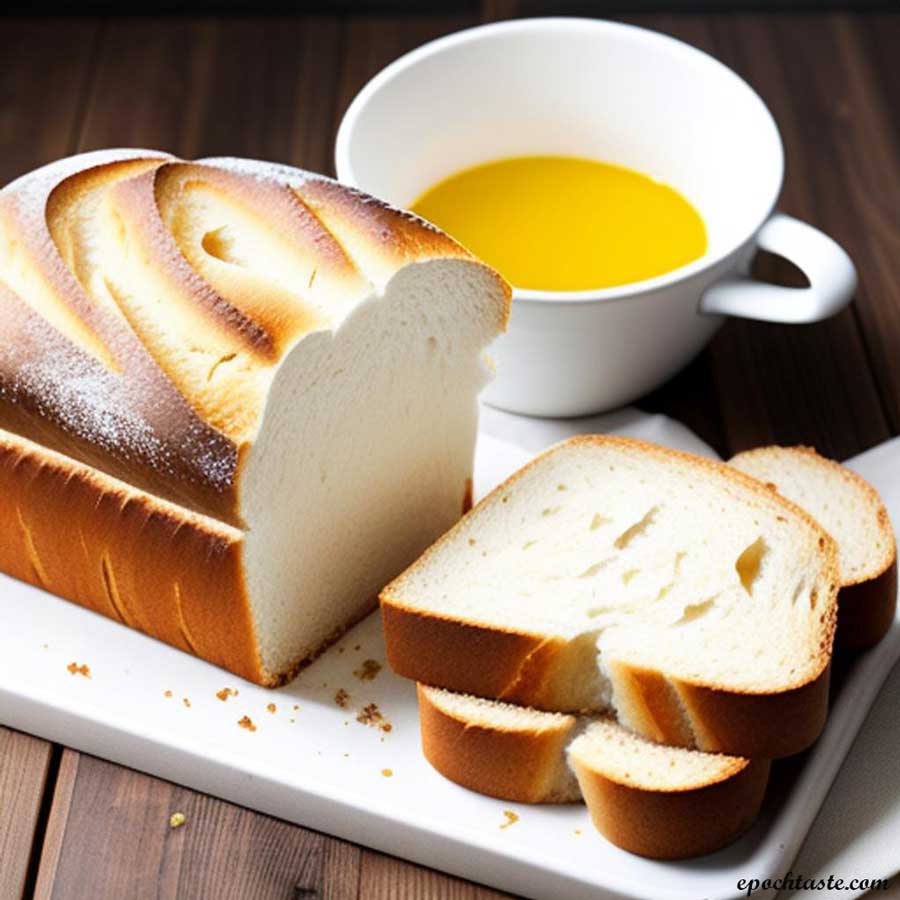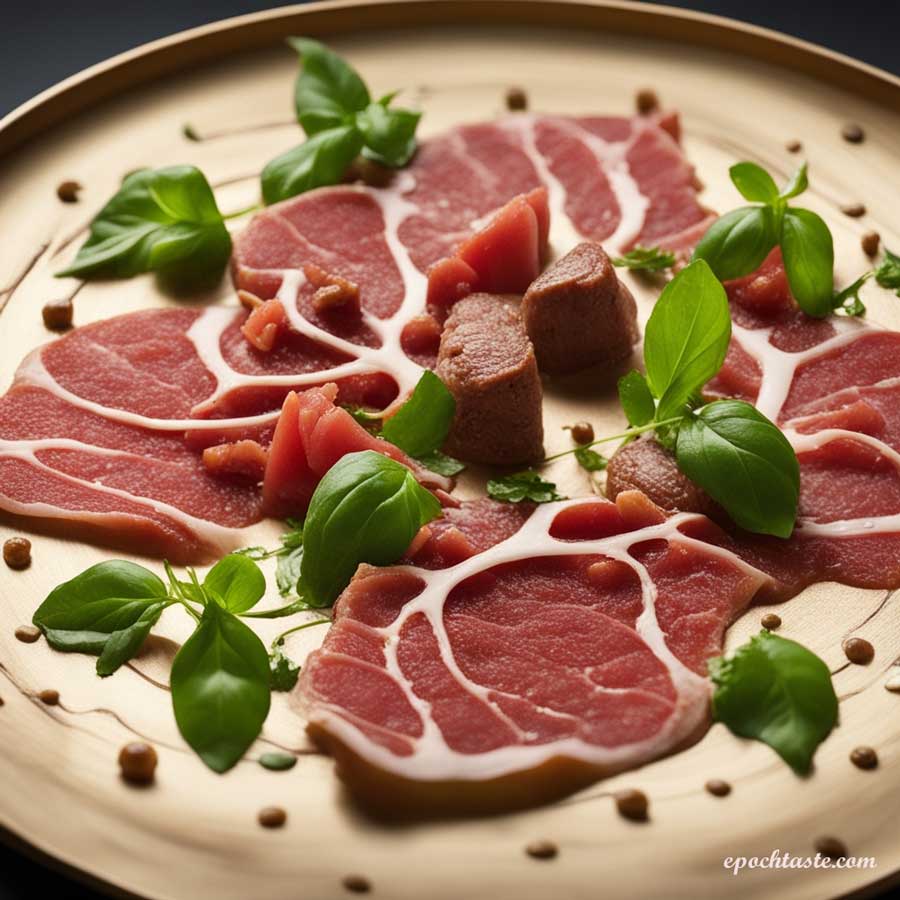Bread, often referred to as the “staff of life,” holds a special place in our hearts and on our tables. There’s nothing quite like the aroma of freshly baked bread filling your kitchen, and the taste of warm, homemade white bread is unmatched. In this comprehensive guide, we’ll explore a variety of easy white bread recipes that cater to different preferences and skill levels. Whether you’re a seasoned baker or a novice in the kitchen, you’ll find a recipe here that suits your needs.
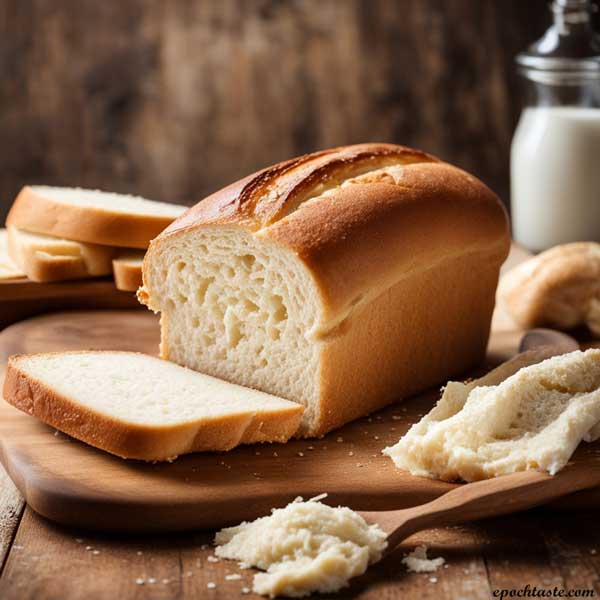
Chapter 1: The Joy of Baking Homemade Bread
Before we delve into the recipes, let’s take a moment to appreciate the art of baking homemade bread. There’s something incredibly satisfying about creating bread from scratch, and it’s a skill that can be honed with practice. Here are a few tips to keep in mind:
- Ingredients: The key to great bread is quality ingredients. Use high-quality flour, fresh yeast, and other fresh ingredients for the best results.
- Kneading: Proper kneading helps develop gluten, giving your bread structure and texture. Knead until the dough is smooth and elastic.
- Rising: Allowing the dough to rise is crucial for bread-making. It gives the yeast time to work its magic, creating the characteristic rise and flavor of bread.
- Baking: Pay attention to the baking time and temperature. A properly baked loaf should be golden brown and sound hollow when tapped on the bottom.
Now, let’s explore a variety of easy white bread recipes that you can try at home.

Chapter 2: Classic Homemade White Bread
This simple white bread recipe is a staple in many households. It’s perfect for sandwiches, toast, or simply enjoying with butter and jam.
Ingredients:
- 4 cups all-purpose flour
- 1 1/2 cups warm water
- 2 teaspoons active dry yeast
- 2 tablespoons sugar
- 2 teaspoons salt
- 2 tablespoons vegetable oil
Instructions:
- In a bowl, dissolve the sugar in warm water. Sprinkle the yeast over the water and let it sit for about 5 minutes, or until it becomes foamy.
- Stir in salt and vegetable oil.
- Gradually add the flour, one cup at a time, stirring until the dough comes together.
- Turn the dough onto a floured surface and knead for about 8-10 minutes, or until it becomes smooth and elastic.
- Place the dough in a greased bowl, cover it with a clean kitchen towel or plastic wrap, and let it rise in a warm place for about 1-1.5 hours, or until it has doubled in size.
- Punch down the dough and divide it in half.
- Shape each half into a loaf and place them in greased loaf pans.
- Cover the pans and let the dough rise again for about 30-45 minutes.
- Preheat your oven to 375°F (190°C).
- Bake the loaves for 25-30 minutes or until they’re golden brown and sound hollow when tapped on the bottom.
- Allow the bread to cool on a wire rack before slicing.
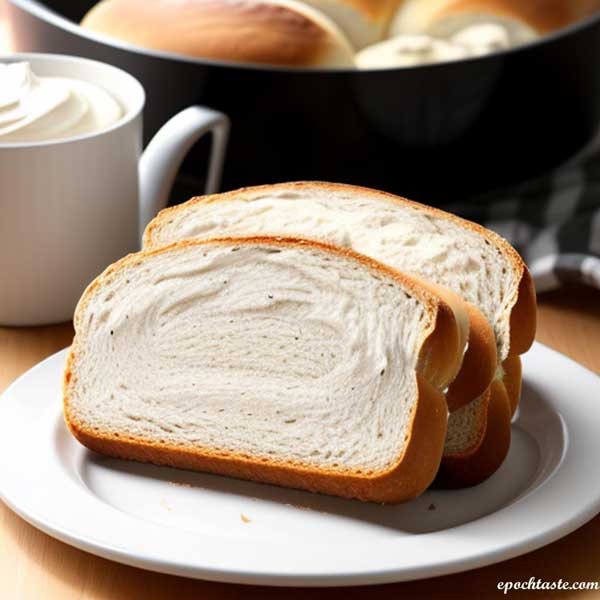
Chapter 3: No-Fuss No-Yeast White Bread
If you’re looking for a simple bread recipe that doesn’t require yeast, this quick and easy no-yeast white bread is perfect.
Ingredients:
- 3 cups all-purpose flour
- 2 tablespoons baking powder
- 1 1/2 teaspoons salt
- 1 1/4 cups milk
- 2 tablespoons vegetable oil
- 2 tablespoons sugar
Instructions:
- Preheat your oven to 375°F (190°C). Grease a loaf pan.
- In a large mixing bowl, combine the flour, baking powder, salt, and sugar.
- Add the milk and vegetable oil, and stir until a dough forms.
- Knead the dough lightly on a floured surface for a few minutes.
- Shape the dough into a loaf and place it in the greased loaf pan.
- Bake for 35-40 minutes or until the bread is golden brown and sounds hollow when tapped on the bottom.
- Let the bread cool before slicing.
Chapter 4: Bread Machine White Bread
If you have a bread machine, making homemade white bread is even easier. Just load the ingredients, press a button, and let the machine do the work.
Ingredients:
- 1 1/2 cups warm water
- 2 tablespoons white sugar
- 2 1/4 teaspoons bread machine yeast
- 1/4 cup vegetable oil
- 4 cups bread flour
- 1 1/2 teaspoons salt
Instructions:
- Place the warm water, sugar, and yeast in the bread machine pan. Allow it to sit for about 10 minutes, or until the mixture becomes frothy.
- Add the vegetable oil, flour, and salt to the yeast mixture.
- Select the Basic or White Bread setting on your bread machine.
- Start the machine, and let it run through the entire cycle.
- Once the baking cycle is complete, carefully remove the bread from the machine and let it cool on a wire rack before slicing.
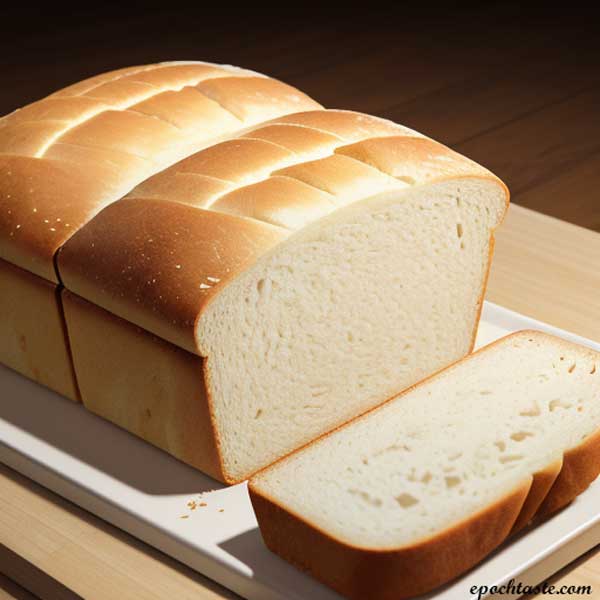
Chapter 5: One-Loaf White Bread Recipe
If you’re baking for a smaller household or just want a single loaf of white bread, this one-loaf recipe is ideal.
Ingredients:
- 2 1/4 teaspoons active dry yeast
- 1 1/2 cups warm water
- 2 tablespoons sugar
- 3 1/2 cups all-purpose flour
- 2 teaspoons salt
- 2 tablespoons vegetable oil
Instructions:
- In a bowl, dissolve the sugar in warm water. Sprinkle the yeast over the water and let it sit for about 5 minutes, or until it becomes frothy.
- Stir in salt and vegetable oil.
- Gradually add the flour, one cup at a time, stirring until a dough forms.
- Turn the dough onto a floured surface and knead for about 8-10 minutes, or until it becomes smooth and elastic.
- Place the dough in a greased bowl, cover it with a clean kitchen towel or plastic wrap, and let it rise in a warm place for about 1-1.5 hours, or until it has doubled in size.
- Punch down the dough and shape it into a loaf.
- Place the loaf in a greased loaf pan, cover it, and let it rise again for about 30-45 minutes.
- Preheat your oven to 375°F (190°C).
- Bake the loaf for 25-30 minutes or until it’s golden brown and sounds hollow when tapped on the bottom.
- Allow the bread to cool on a wire rack before slicing.
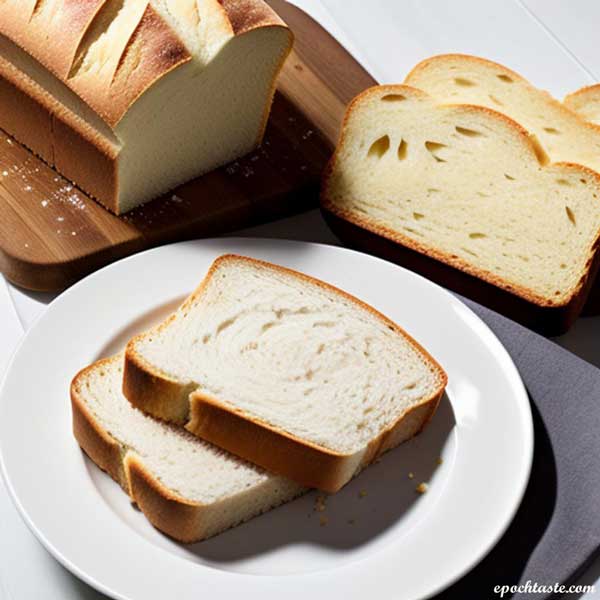
Chapter 6: White Bread with Milk
Adding milk to your white bread recipe results in a softer and slightly sweeter loaf. It’s perfect for those who prefer a milder flavor.
Ingredients:
- 1 cup warm milk
- 1/2 cup warm water
- 2 tablespoons sugar
- 2 1/4 teaspoons active dry yeast
- 3 1/2 cups all-purpose flour
- 1 1/2 teaspoons salt
- 2 tablespoons vegetable oil
Instructions:
- In a bowl, dissolve the sugar in warm milk and warm water. Sprinkle the yeast over the mixture and let it sit for about 5 minutes, or until it becomes frothy.
- Stir in salt and vegetable oil.
- Gradually add the flour, one cup at a time, stirring until a dough forms.
- Turn the dough onto a floured surface and knead for about 8-10 minutes, or until it becomes smooth and elastic.
- Place the dough in a greased bowl, cover it with a clean kitchen towel or plastic wrap, and let it rise in a warm place for about 1-1.5 hours, or until it has doubled in size.
- Punch down the dough and shape it into a loaf.
- Place the loaf in a greased loaf pan, cover it, and let it rise again for about 30-45 minutes.
- Preheat your oven to 375°F (190°C).
- Bake the loaf for 25-30 minutes or until it’s golden brown and sounds hollow when tapped on the bottom.
- Allow the bread to cool on a wire rack before slicing.
Chapter 7: The Best Homemade White Bread
If you’re looking for the ultimate homemade white bread recipe, this one promises to deliver exceptional flavor and texture.
Ingredients:
- 4 cups bread flour
- 1 1/2 cups warm water
- 2 teaspoons active dry yeast
- 2 tablespoons sugar
- 2 teaspoons salt
- 2 tablespoons unsalted butter, softened
Instructions:
- In a bowl, dissolve the sugar in warm water. Sprinkle the yeast over the water and let it sit for about 5 minutes, or until it becomes frothy.
- Stir in salt and softened unsalted butter.
- Gradually add the bread flour, one cup at a time, stirring until a dough forms.
- Turn the dough onto a floured surface and knead for about 8-10 minutes, or until it becomes smooth and elastic.
- Place the dough in a greased bowl, cover it with a clean kitchen towel or plastic wrap, and let it rise in a warm place for about 1-1.5 hours, or until it has doubled in size.
- Punch down the dough and shape it into a loaf.
- Place the loaf in a greased loaf pan, cover it, and let it rise again for about 30-45 minutes.
- Preheat your oven to 375°F (190°C).
- Bake the loaf for 25-30 minutes or until it’s golden brown and sounds hollow when tapped on the bottom.
- Allow the bread to cool on a wire rack before slicing.
Chapter 8: Conclusion
In this guide, we’ve explored a variety of easy white bread recipes, each offering its own unique qualities and flavors. Whether you’re looking for a classic, no-yeast, bread machine, one-loaf, milk-enriched, or the best homemade white bread recipe, you’re now equipped to create delicious homemade bread that your family and friends will adore.
Homemade bread not only fills your home with a delightful aroma but also provides you with the satisfaction of knowing you’ve created something from scratch. So, don your apron, gather your ingredients, and embark on a delightful baking journey. With these easy white bread recipes, you’ll be baking up perfection in no time. Enjoy every slice!
Chapter 9: Bonus Recipe – Easy White Bread Rolls
Ingredients:
- 2 1/4 teaspoons active dry yeast
- 1 1/2 cups warm water
- 2 tablespoons sugar
- 3 1/2 cups all-purpose flour
- 1 1/2 teaspoons salt
- 2 tablespoons vegetable oil
Instructions:
- In a bowl, dissolve the sugar in warm water. Sprinkle the yeast over the water and let it sit for about 5 minutes, or until it becomes frothy.
- Stir in salt and vegetable oil.
- Gradually add the flour, one cup at a time, stirring until a dough forms.
- Turn the dough onto a floured surface and knead for about 8-10 minutes, or until it becomes smooth and elastic.
- Place the dough in a greased bowl, cover it with a clean kitchen towel or plastic wrap, and let it rise in a warm place for about 1-1.5 hours, or until it has doubled in size.
- Punch down the dough and divide it into 12 equal portions.
- Shape each portion into a ball and place them on a greased baking sheet.
- Cover the rolls and let them rise again for about 30-45 minutes.
- Preheat your oven to 375°F (190°C).
- Bake the rolls for 15-18 minutes or until they’re golden brown and sound hollow when tapped on the bottom.
- Allow the rolls to cool on a wire rack before serving.
Chapter 10: Frequently Asked Questions
Q1: Can I use whole wheat flour in these recipes?
Yes, you can substitute whole wheat flour for a portion of the all-purpose flour in most of these recipes if you prefer a heartier texture and flavor. Start by replacing up to half of the all-purpose flour with whole wheat flour and adjust the liquid as needed to achieve the desired dough consistency.
Q2: How do I store homemade white bread?
To keep your homemade white bread fresh, store it in an airtight container or a resealable plastic bag at room temperature for up to 2-3 days. If you have more bread than you can consume in that time, consider freezing it in a freezer-safe bag or container for longer storage. Thaw frozen bread at room temperature or in the refrigerator when you’re ready to enjoy it.
Q3: Can I make these recipes without a stand mixer?
Absolutely! While a stand mixer can be convenient for kneading, all of these recipes can be made by hand. Simply combine the ingredients in a bowl, mix until a dough forms, and then knead the dough on a floured surface until it’s smooth and elastic.
Q4: How can I customize these recipes with additional ingredients?
Feel free to get creative with your bread recipes by adding ingredients like herbs, spices, seeds, nuts, dried fruits, or grated cheese. Just fold them into the dough during the final stages of kneading to evenly distribute the flavors throughout your bread.
Q5: What is the best way to achieve a golden crust on my bread?
To achieve a beautiful golden crust on your bread, you can brush the dough with an egg wash (a beaten egg mixed with a tablespoon of water) just before baking. This will give your bread a shiny and golden finish.
Chapter 11: Additional Resources
As you continue your bread-making journey, there are plenty of resources available to help you expand your skills and knowledge. Here are some recommended books, websites, and communities:
- Books:
- “The Bread Baker’s Apprentice” by Peter Reinhart
- “Flour Water Salt Yeast” by Ken Forkish
- “Bread: A Baker’s Book of Techniques and Recipes” by Jeffrey Hamelman
- Websites:
- The Fresh Loaf: A community of bread enthusiasts sharing recipes, tips, and experiences.
- King Arthur Baking: A treasure trove of baking recipes and resources.
- Online Communities:
- Reddit’s r/Breadit: A subreddit dedicated to all things bread-making.
- YouTube Channels:
- Tasty: Offers a variety of bread-making tutorials.
- Alex French Guy Cooking: Features entertaining and informative bread-making videos.
Chapter 12: Share Your Bread-Making Journey
We’d love to hear about your bread-making adventures and see photos of your delicious creations. Share your experiences, tips, and favorite recipes on social media using the hashtag #HomemadeBreadJourney. Together, we can inspire and encourage others to discover the joy of baking homemade bread.
Happy baking!
Chapter 13: Conclusion
Baking homemade bread is a rewarding and comforting experience. Whether you’re a beginner or an experienced baker, these easy white bread recipes offer a range of options to suit your preferences. From classic loaves to no-yeast versions, bread machine convenience to milk-enriched recipes, and the ultimate best homemade white bread, you have a variety of choices to explore.
Remember, each loaf you bake is a unique creation, and the process of making bread can be as satisfying as enjoying the final product. So, gather your ingredients, preheat your oven, and embark on a delightful journey into the world of homemade white bread. The warm, fresh slices that await you are sure to bring comfort and joy to your kitchen and dining table.
Chapter 14: Bonus Recipe – White Bread with Honey
Ingredients:
- 4 cups bread flour
- 1 1/2 cups warm water
- 2 teaspoons active dry yeast
- 2 tablespoons honey
- 2 teaspoons salt
- 2 tablespoons unsalted butter, softened
Instructions:
- In a bowl, dissolve the honey in warm water. Sprinkle the yeast over the water and let it sit for about 5 minutes, or until it becomes frothy.
- Stir in salt and softened unsalted butter.
- Gradually add the bread flour, one cup at a time, stirring until a dough forms.
- Turn the dough onto a floured surface and knead for about 8-10 minutes, or until it becomes smooth and elastic.
- Place the dough in a greased bowl, cover it with a clean kitchen towel or plastic wrap, and let it rise in a warm place for about 1-1.5 hours, or until it has doubled in size.
- Punch down the dough and shape it into a loaf.
- Place the loaf in a greased loaf pan, cover it, and let it rise again for about 30-45 minutes.
- Preheat your oven to 375°F (190°C).
- Bake the loaf for 25-30 minutes or until it’s golden brown and sounds hollow when tapped on the bottom.
- Allow the bread to cool on a wire rack before slicing.
Chapter 15: Frequently Asked Questions
Q1: Can I use a bread machine for the bonus recipe?
Yes, you can adapt the bonus recipe for use in a bread machine. Simply follow your machine’s instructions for adding ingredients, selecting the appropriate setting, and starting the baking process.
Q2: What can I do with leftover bread?
Leftover bread can be transformed into various delicious dishes, such as bread pudding, croutons, or breadcrumbs. Be creative and experiment with different recipes to make the most of your bread.
Q3: Can I make these recipes gluten-free?
Yes, you can experiment with gluten-free flour blends to make gluten-free versions of these recipes. Keep in mind that the texture and taste may vary, so it may take some trial and error to find the perfect gluten-free combination that works for you.
Q4: Can I add seeds or herbs to the bonus recipe?
Certainly! Feel free to customize the bonus recipe by adding your favorite seeds, herbs, or other flavor-enhancing ingredients. Fold them into the dough during the final stages of kneading to evenly distribute the flavors.
Q5: How can I tell when the bread is done baking?
To check if the bread is done, use a thermometer to measure the internal temperature. For most bread, a temperature of around 190-200°F (88-93°C) indicates that it’s fully baked. Additionally, the bread should have a golden brown crust and sound hollow when tapped on the bottom.
Chapter 16: Additional Resources
As you continue your bread-making journey, there are plenty of resources available to help you expand your skills and knowledge. Here are some recommended books, websites, and communities:
- Books:
- “The Bread Baker’s Apprentice” by Peter Reinhart
- “Flour Water Salt Yeast” by Ken Forkish
- “Bread: A Baker’s Book of Techniques and Recipes” by Jeffrey Hamelman
- Websites:
- The Fresh Loaf: A community of bread enthusiasts sharing recipes, tips, and experiences.
- King Arthur Baking: A treasure trove of baking recipes and resources.
- Online Communities:
- Reddit’s r/Breadit: A subreddit dedicated to all things bread-making.
- YouTube Channels:
- Tasty: Offers a variety of bread-making tutorials.
- Alex French Guy Cooking: Features entertaining and informative bread-making videos.
Chapter 17: Share Your Bread-Making Journey
We’d love to hear about your bread-making adventures and see photos of your delicious creations. Share your experiences, tips, and favorite recipes on social media using the hashtag #HomemadeBreadJourney. Together, we can inspire and encourage others to discover the joy of baking homemade bread.
Happy baking!

